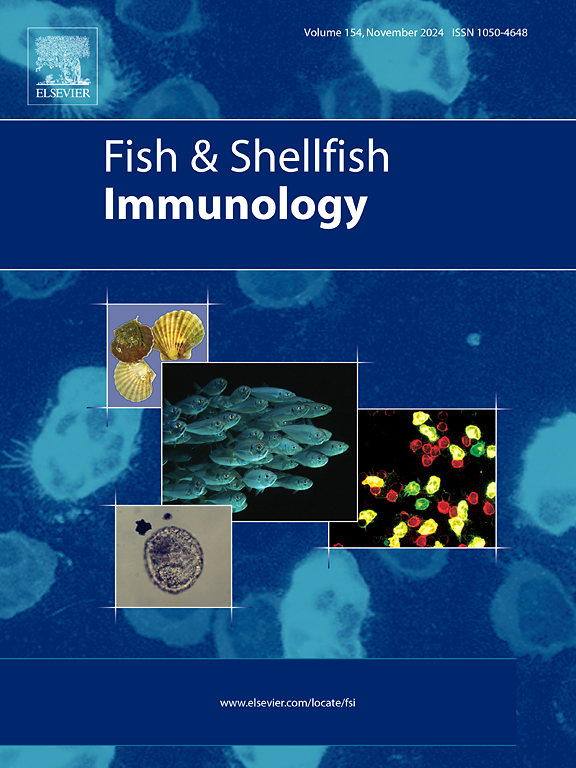转录因子网络驱动罗非鱼抗细菌免疫反应中的穿孔素活性。
IF 4.1
2区 农林科学
Q1 FISHERIES
引用次数: 0
摘要
穿孔素由自然杀伤(NK)细胞和细胞毒性 T 淋巴细胞(CTL)产生,是脊椎动物细胞介导的细胞毒性(CMC)效应物之一,在杀死靶细胞方面发挥着重要作用。然而,穿孔素是否以及如何参与早期脊椎动物的适应性免疫反应仍不清楚。我们以尼罗罗非鱼(Oreochromis niloticus)为模型,研究了穿孔素在早期脊椎动物中的特性。尼罗罗非鱼穿孔素(OnPRF)具有两个保守的功能域,即膜攻击复合体/穿孔素(MACPF)和蛋白激酶C保守区2(C2)域,但它们与其他同源物的氨基酸序列相似性较低。OnPRF 在各种免疫组织中广泛表达,并能在体外对淋巴细胞活化和 T 细胞活化做出转录和蛋白水平的反应,表明它可能参与了适应性免疫反应。此外,在鱼类感染Edwardsiella piscicida和嗜水气单胞菌后,OnPRF的mRNA和蛋白质水平在适应性免疫反应期内显著上调。此外,我们还发现许多转录因子参与了 OnPRF 的转录调控,包括 p65、c-Fos、c-Jun、STAT1 和 STAT4,并且这些转录因子之间存在协同作用。总之,这些发现证明了OnPRF参与了罗非鱼T细胞活化和适应性免疫反应,从而为理解早期脊椎动物免疫反应的进化提供了新的证据。本文章由计算机程序翻译,如有差异,请以英文原文为准。
Transcription factor networks drive perforin activity in the anti-bacterial immune response of tilapia
Perforin, produced by natural killer (NK) cells and cytotoxic T lymphocytes (CTLs), is one of the effectors of cell-mediated cytotoxicity (CMC) in vertebrates, playing a paramount role in killing target cells. However, whether and how perforin is involved in adaptive immune responses in early vertebrates remains unclear. Using Nile tilapia (Oreochromis niloticus) as a model, we investigated the characteristics of perforin in early vertebrates. Oreochromis niloticus perforin (OnPRF) possesses 2 conserved functional domains, membrane attack complex/perforin (MACPF) and protein kinase C conserved region 2 (C2) domains, although they share low amino acid sequence similarity with other homologs. OnPRF was widely expressed in various immune tissues and could respond to lymphocyte activation and T-cell activation in vitro at both the transcriptional and protein levels, indicating that it may be involved in adaptive immune responses. Furthermore, after infection with Edwardsiella piscicida and Aeromonas hydrophila, the mRNA and protein levels of OnPRF were significantly up-regulated within the adaptive immune response period. Additionally, we revealed that many transcription factors were involved in the transcriptional regulation of OnPRF, including p65, c-Fos, c-Jun, STAT1 and STAT4, and there was a synergy among these transcription factors. Overall, these findings demonstrate the involvement of OnPRF in T-cell activation and adaptive immune response in tilapia, thus providing new evidence for comprehending the evolution of immune response in early vertebrates.
求助全文
通过发布文献求助,成功后即可免费获取论文全文。
去求助
来源期刊

Fish & shellfish immunology
农林科学-海洋与淡水生物学
CiteScore
7.50
自引率
19.10%
发文量
750
审稿时长
68 days
期刊介绍:
Fish and Shellfish Immunology rapidly publishes high-quality, peer-refereed contributions in the expanding fields of fish and shellfish immunology. It presents studies on the basic mechanisms of both the specific and non-specific defense systems, the cells, tissues, and humoral factors involved, their dependence on environmental and intrinsic factors, response to pathogens, response to vaccination, and applied studies on the development of specific vaccines for use in the aquaculture industry.
 求助内容:
求助内容: 应助结果提醒方式:
应助结果提醒方式:


